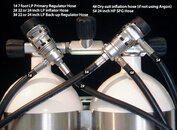First, what regulators do you own?
With an L shaped regulator like the Scubapro Mk 5, Mk 10, Mk 15, Mk 20, Mk 25, or a Mk 21 with the optional end port, the right hand regulator is positioned so that the long hose comes out the end port pointed down toward your can light on the right hip, keeping it tucked in close to the body without forming any loop. That also lets the DS inflator hose on the turret point in toward the diver and over the shoulder which again avoids any loop in the hose.
On the left hand regulator angling the end port of the first stage outward in the opposite direction (pointing at the left hip d-ring), allows the HP hose on the side of the first stage to point downward where it stays streamlined. And in the same fashion it allows the back up regulator hose to route directly around the neck and allows theBC inflator hose to route cleanly over the shoulder.
Given that this first stage layout is common, this hose configuration is common as well.
However, it's not the only configuration you'll see.
For a balanced diaphragm first stage with 1 HP and 2 LP ports on each side of the regulator, you position the first stages on their sides so that the HP hose on the left reg points down for clean routing, while the back up reg and BC inflator hose route down and then bend back up and over shoulder or around the neck. On the right side the long hose and DS inflator hose also route down, with the inflator hose coming back up over the shoulder.
This approach is a little cleaner overall, but it puts a little more bend in a couple of the hoses.
In that regard, you tailor the hose routing to the type of first stage you have to avoid any loops in the hoses that stick out away from the body, and to avoid any sharp bends in the hoses that may lead to failure.
Some divers will use a 90 degree swivel or elbow for the inflator and/or back up second stage hose(s) to avoid any bend in the hose(s) at all. It's a mixed bag however, as with a swivel you're adding a dymamic o-ring and a static o-ring to the system, as well as a swivel joint that is help together by a screw that can fail. At a minimum, you don't want to use cheap swivel and you'll need to pay close attention to it's health over the dive season.







